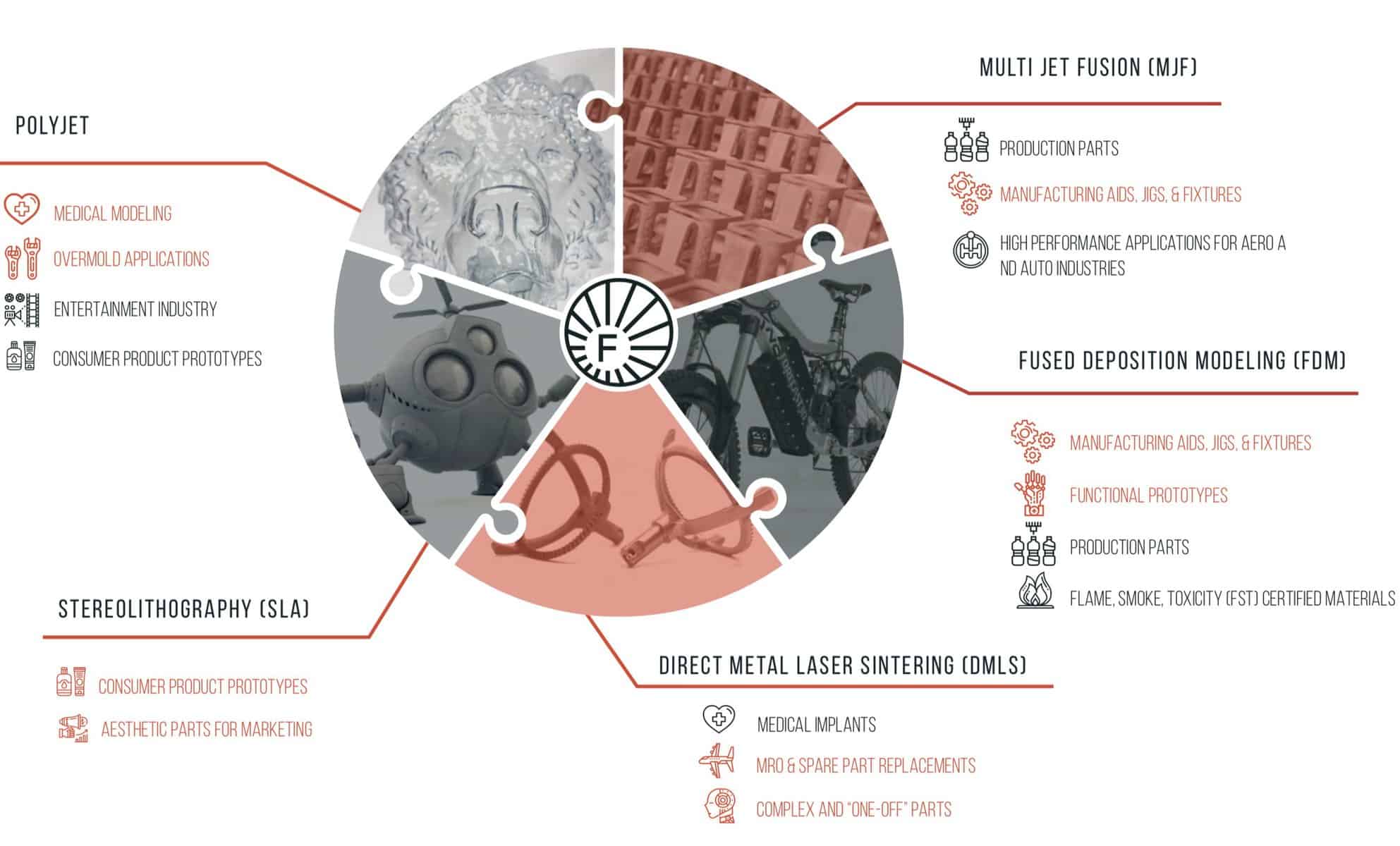Intro to Additive Manufacturing:
Complementary Technologies
Additive Manufacturing technology has existed since the early 1980’s. The umbrella of AM now includes a wide variety of layering technology and sintering processes that validate a plethora of materials—from soft-touch, rubber-like gaskets and overmolds to steel and titanium parts used for human implants and functional automotive replacement parts. Materials are the lifeblood of these printers, so it’s important to understand the basics of each technology. To put it into perspective, you wouldn’t use a screw with a hammer, just like a screwdriver would be ineffective with a nail. Considering that there are different tools for different jobs, let’s understand the technology.
Complementary Technologies
It’s impossible to assume that one technology will solve all of your prototyping, design and production needs. This is challenging for those who wish to purchase equipment and bring the capability in-house. Therefore, it’s important to consider partnering with technology-agnostic organizations that have access to complementary machinery, such as service bureaus or universities. It’s cost effective and safe. According to a recent study, the number of companies using AM service providers has tripled since 2016. Of those, 81% cite a reluctance to invest in their own systems, and another 71/% of companies say that a lack of knowledge is the greatest factor on project-by-project choices to use 3D printing or traditional methods. Simply put, they are not the experts (source: AMFG).

Multi Jet Fusion
HP’s Multi Jet Fusion (MJF) has seen unprecedented growth since its introduction in 2016. More than 10 million parts were produced using MJF 3D printers in 2018, and its utilization has only increased. MJF is based on binder jetting technology that utilizes a binding agent with a powder bed to fuse parts together. Due to the uniqueness of the MJF printing process, materials are built with isotropic strength properties (x, y, and z). Primary materials capable of MJF include Nylon PA 11, 12 and TPU. This makes it ideal for several applications:
- Production parts
- Manufacturing aids, jigs & fixtures
- High-performance applications for aero and auto industries
Fused Deposition Modeling
Fused Deposition Modeling (FDM), sometimes referred to as Fused Filament Fabrication (FFF), is by far the most common 3D printing method available in the marketplace. Due to the ease of use and ABS material properties, there are now countless versions of FDM printers currently offered. BUT BUYER BEWARE. Hobbyist FDM printers have grown in popularity due to their consumer-like price range. This document will focus on the professional level equipment that enables engineers and designers to deliver repeatable and reliable results using materials such as ULTEM-9085 for aerospace applications and Polycarbonate to create functional prototypes or manufacturing aids.
- Manufacturing aids, jigs & fixtures
- Functional prototypes
- Production parts
- FST certified materials (flame, smoke, toxicity)
Direct Metal Laser Sintering
Direct Metal Laser Sintering (DMLS) is one of the most advanced additive technologies enabling production facilities to print a wide variety of metals. In 2018, the metal AM market was estimated at $1.6 billion and is experiencing a 25% CAGR since that time. Unlike filament printers, DMLS uses very fine, granular aluminum or titanium powder to produce parts. These parts require certain design and post processing considerations, which tend to be labor intensive and require special facility requirements. Therefore, it’s no surprise that many organizations outsource their DMLS requests, which are perfect for:
- Titanium parts for medical implants
- MRO and spare part replacements
- One-off production parts
- Impossible to produce parts
Stereolithography
Stereolithography (SLA) 3D printing was pioneered during the 1980’s and is still considered a cost effective option for those who wish to create high detail prototypes with excellent quality and surface finishes. Photosensitive resins are cured using a near-UV laser beam which partly solidifies the part. Layer-by-layer, the part builds through the curing process, resulting in a three-dimensional object. Oftentimes, SLA printing is used when researchers and scientists wish to create anatomically accurate models from CT or MRI scan data. In addition, SLA printing can be used for:
- Consumer product prototypes
- Aesthetic parts used for marketing purposes
- Translucent applications (eyewear)
- Medical modeling
PolyJet
PolyJet is based on inkjet technology that combines UV light with photopolymers to create parts with a wide variety of mechanical properties. The uniqueness of PolyJet technology enables engineers to combine hard and soft materials resulting in gradient shore values or durometers. This has become revolutionary for designers to create soft-touch parts and overmolds typically seen in the consumer product industries. Similar to SLA, this printing process is an ideal option for medical modeling applications. In addition, PolyJet has been used for many artistic applications used in film, media and sculpturing.
- Medical modeling
- Overmold applications (Soft-touch, grips, gaskets)
- Entertainment industry
- Consumer product prototypes
